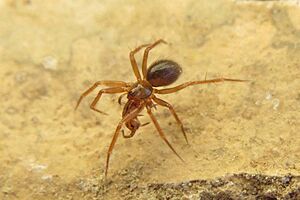Horrid ground-weaver facts for kids
Quick facts for kids Horrid ground-weaver |
|
|---|---|
 |
|
| A male Nothophantes horridus | |
| Conservation status | |
| Scientific classification |
The horrid ground-weaver (scientific name: Nothophantes horridus) is a tiny spider. It is very rare and is considered critically endangered, which means it's at high risk of disappearing forever. This spider is the only species in its group, or genus, called Nothophantes. It's a type of dwarf spider found only in a small part of Europe, specifically near Plymouth in the UK. Scientists P. Merrett and R. A. Stevens first described it in 1995. The name Nothophantes comes from Ancient Greek words meaning "false weaver," and horridus comes from Latin, meaning "bristly."
Contents
About the Horrid Ground-Weaver
The horrid ground-weaver is a very small spider. It measures only about 2.5 millimetres (0.098 in) long. That's about the size of a tiny ant! Because of its small size, it's very hard to spot.
Where it Lives
This spider has only been found in a few places. These include three old limestone quarries and one industrial area. All these spots are in the Cattedown area of Plymouth. One of the first places it was found, Shapter's Field Quarry, has since been built over. It is now an industrial estate. The spiders like to live deep inside cracks and tiny spaces in rocks. This makes them even harder to find.
History of Discovery
The horrid ground-weaver was first discovered in 1995. After that, it wasn't seen again until 1999. For a long time, up until 2016, only nine of these spiders had ever been found. Seven of them were female, and two were male. In 2016, a photo of the spider was taken for the first time at a new location. In September 2011, the horrid ground-weaver was even featured on a BBC Radio 4 show called Saving Species.
Protecting the Spider
Because the horrid ground-weaver is so rare, people have worked hard to protect it.
Stopping Building Plans
In 2014, a company wanted to build homes in Radford Quarry. This quarry was one of the places where the spider lives. Plymouth City Council said no to the building plans. The company tried to appeal this decision, which led to a formal public inquiry.
Public Support and Success
In 2015, a group called Buglife started an online petition. They wanted to save the horrid ground-weaver from disappearing. Nearly 10,000 people signed this petition! People also helped by donating money, raising almost £10,500. This money was used to study the spider more.
In June of that year, a big international group called the IUCN officially listed the spider as critically endangered. This added it to the global Red List of Threatened Species. On June 9, the Planning Inspector made a final decision. They rejected the building plans because of concerns for rare wildlife, especially the horrid ground-weaver. This was a big win for the tiny spider!


